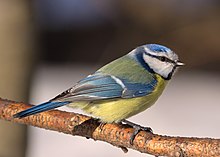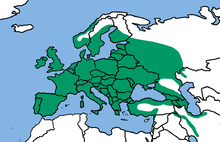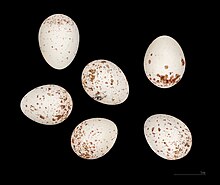蓝山雀
| 蓝山雀 | |
|---|---|

| |
| 科学分类 | |
| 界: | 动物界 Animalia |
| 门: | 脊索动物门 Chordata |
| 纲: | 鸟纲 Aves |
| 目: | 雀形目 Passeriformes |
| 科: | 山雀科 Paridae |
| 属: | 蓝山雀属 Cyanistes |
| 种: | 蓝山雀 C. caeruleus
|
| 二名法 | |
| Cyanistes caeruleus (Linnaeus, 1758)
| |

| |
| 异名 | |
|
Parus caeruleus | |
蓝山雀(学名: Cyanistes caeruleus),又名蓝冠山雀,是长10.5-12厘米的山雀。它们分布在欧洲温带及亚北极带并西亚的林地。它们并非候鸟。
分类
[编辑]蓝山雀最先由卡尔·林奈(Carolus Linnaeus)于1758年命名为Parus caeruleus。[2]
虽然很多学者都将Cyanistes看为山雀属的亚属,但是英国鸟类学会(British Ornithologists' Union)却将它定为独立的属。线粒体DNA的细胞色素b序列分析亦支持这个分类,并且指出Cyanistes非其他山雀的近亲。[3]
蓝山雀在加那利群岛及非洲西北部(由摩洛哥北部至利比亚北部)的两个传统亚种各有不同。加那利群岛亚种有黑冠,而非洲亚种则有蓝冠。现正研究是否将这两个亚种定为独自的物种。[4][5][6]这两个物种分别为:
- Parus ultramarinus Bonaparte, 1841:可能包含了三或四个亚种,即P. u. palmensis、P. u. ombriosus及P. u. ultramarinus/degener;
- Parus teneriffae Lesson, 1831:包含了指名亚种的P. t. teneriffae及未命名的亚种。
俄罗斯西部的灰蓝山雀与蓝山雀的混种(Cyanistes × pleskei)亦很普遍。
描述
[编辑]
蓝山雀有蓝色的冠,眼睛间有一条蓝线。前额呈白色,双翼上有一白间。颈部、双翼及尾巴都呈蓝色。背部呈黄绿色。大部分下身呈硫黄色,腹部有一深纹。喙呈黑色,脚呈灰蓝色,瞳孔呈深褐色。雏鸟明显较黄。
蓝山雀是欧洲普遍的观赏鸟,在吃食的时间予人洋洋得意的感觉。
蓝山雀差不多全年也会唱歌,最频密的是介乎2月至6月间。
行为
[编辑]蓝山雀与大山雀在冬天一起生活,蓝山雀较喜欢栖息在幼长的树枝上。蓝山雀经常会像旅木雀科般在树干向上跳。它们会栖息在常春藤或常绿植物上,但在恶劣天气时则会避到洞中。蓝山雀很灵活,差不多可以挂在任何地方。
蓝山雀平均寿命约1.5岁。[7]

食性
[编辑]蓝山雀会捕猎害虫,但却并非完全是有益的物种。它们喜欢吃不同树上的芽,并会将芽拉出来吸引昆虫。没有其他物种比它们破坏更多的蚜虫。它们会吃潜叶虫及卷叶虫。它们亦会吃种子。
繁殖
[编辑]

蓝山雀可以在很多树孔、墙孔、树桩或巢箱上筑巢,并与家麻雀或大山雀争取筑巢的地点。蓝山雀每年都会回到同一穴上。当蓝山雀死后,另一对蓝山雀会占用该巢。
蓝山雀会紧紧的照顾雏鸟。它们会挺起胸膛来保护鸟蛋,不过它们并非发怒,而是处于兴奋状态,因为它们求爱时亦会装出同样的姿势。它们会以苔藓、毛线及羽毛筑巢,每年约于4月或5月生蛋。每胎都会生下大量的蛋,一般都有7-8颗。
保育
[编辑]蓝山雀在寒冬的数量会减少。
参考
[编辑]- ^ BirdLife International. Parus caeruleus. The IUCN Red List of Threatened Species 2004. [2006-05-12].
- ^ (拉丁文) Linnaeus, C. Systema naturae per regna tria naturae, secundum classes, ordines, genera, species, cum characteribus, differentiis, synonymis, locis. Tomus I. Editio decima, reformata.. Holmiae. (Laurentii Salvii). 1758: 190.
P. remigibus caerulescentibus : primoribus margine exteriore albis, fronte alba, vertice caeruleo.
- ^ Gill, Frank B.; Slikas, Beth & Sheldon, Frederick H. Phylogeny of titmice (Paridae): II. Species relationships based on sequences of the mitochondrial cytochrome-b gene. Auk. 2005, 122: 121–143. doi:10.1642/0004-8038(2005)122[0121:POTPIS]2.0.CO;2.
- ^ Kvist, Laura: Broggi, J.; Illera, J.C.; Koivula, K. Colonisation and diversification of the blue tits (Parus caeruleus teneriffae-group) in the Canary Islands. Molecular Phylogenetics and Evolution. 2005, 34: 501–511. doi:10.1016/j.ympev.2004.11.017.
- ^ Kvist, Laura. Response to "Taxonomic status of 'phylogroups' in the Parus teneriffae complex (Aves)" by George Sangster. Molecular Phylogenetics and Evolution. 2006, 38: 290. doi:10.1016/j.ympev.2005.10.012.
- ^ Sangster, George. The taxonomic status of 'phylogroups' in the Parus teneriffae complex (Aves): Comments on the paper by Kvist et al. (2005). Molecular Phylogenetics and Evolution. 2006, 38: 288–289. doi:10.1016/j.ympev.2005.10.009.
- ^ British Garden Birds. Life Expectancy. [2008-10-19]. (原始内容存档于2007-04-24).
外部链接
[编辑]- ARKive - images and movies of the blue tit (Parus caeruleus)
- The Royal Society for the Protection of Birds (Blue Tit) (页面存档备份,存于互联网档案馆)
- Blue Tit call
- Blue Tit videos on the Internet Bird Collection
- Blue Tit nest 2006 part (1) (页面存档备份,存于互联网档案馆), (2) (页面存档备份,存于互联网档案馆), (3) (页面存档备份,存于互联网档案馆), (4) (页面存档备份,存于互联网档案馆), (5) (页面存档备份,存于互联网档案馆), (6) (页面存档备份,存于互联网档案馆), (7) (页面存档备份,存于互联网档案馆), (8) (页面存档备份,存于互联网档案馆), (9) (页面存档备份,存于互联网档案馆), (10), (11) (页面存档备份,存于互联网档案馆) at Google Video
- young Blue Tits leave the nest for the first time (页面存档备份,存于互联网档案馆) at Google Video
- Ageing and sexing (PDF) by Javier Blasco-Zumeta
- - Ysgol Bod Alaw - Blue Tit web cam

